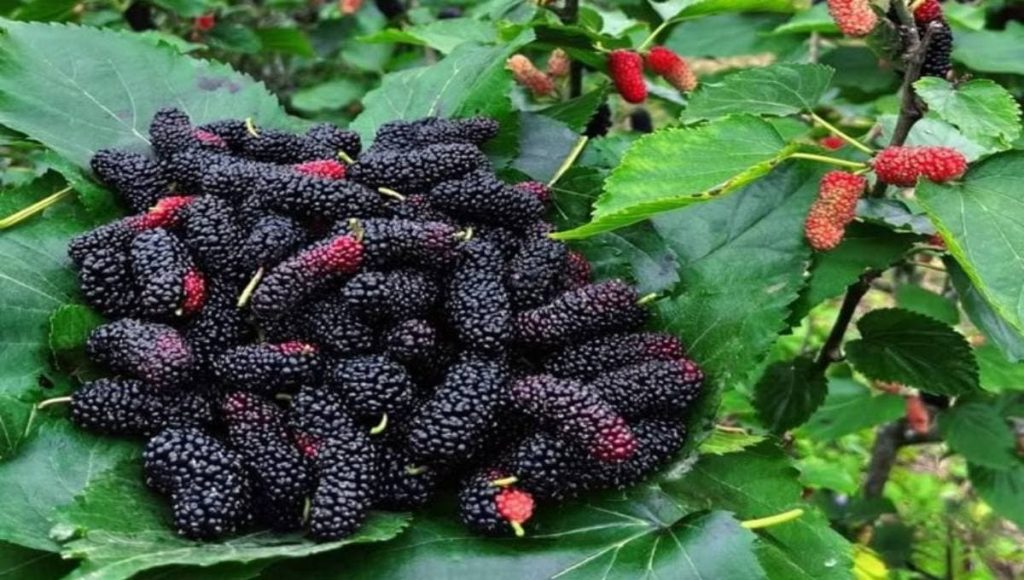
മൾബറി ചെടി നടാൻ ഇത്ര എളുപ്പമോ Mulberry Farming Tips
ഒരുപാട് ഔഷധ ഗുണങ്ങൾ ഉള്ള ഒരു പഴമാണ് മൾബറി.ഇതിൽ കുറെ വിറ്റാമിൻ അടങ്ങിയിട്ടുണ്ട്
വീടുകളിൽ ഇത് എളുപ്പത്തിൽ ഉണ്ടാകും.കുട്ടികൾക്ക് ഒരുപാട് ഇഷ്ടം ഉള്ളതാണ്.ഇത് ഒരുപാട് ഉണ്ടാകും. പഴുത്തു തുടങ്ങുമ്പോൾ ചുവപ്പും നന്നായി പഴുക്കുമ്പോൾ കറുപ്പും നിറമാണ് മൾബറിക്ക് ഉണ്ടാകുക.ജ്യൂസ് ആക്കിയും സ്ക്വാഷ് ആക്കിയും ഇത് സൂക്ഷിക്കാം.മൾബറി പഴം എത്രമാത്രം ആരോഗ്യകരം ആണെന്ന് പലർക്കും അറിയില്ല. അറിഞ്ഞാൽ ഒരു മൾബറി ചെടി നട്ടുപിടിപ്പിക്കാൻ നിങ്ങൾ മറക്കില്ല
മൾബറി നടുമ്പോൾ ശ്രദ്ധിക്കേണ്ട ചില കാര്യങ്ങൾ നോക്കാം.

മൾബറി നടുമ്പോൾ നല്ല വെയിൽ കിട്ടുന്ന സ്ഥലത്ത് നടുക, എന്തങ്കിലും ജീവികളുടെ ശല്യം ഉണ്ടെങ്കിൽ നെറ്റ് ഇടാം, കാട്ട് മൾബറി ആണെങ്കിൽ നല്ല ഉയരത്തിൽ വലുതാവും.
ചില മൾബറി ചെടികൾ അധികം ഉയരത്തിൽ വളരാതെ നിൽക്കും വളരെ എളുപ്പത്തിൽ മൾബറി കായി പറിക്കാം, മുകളിലേക്ക് പോവുന്ന കൊമ്പ് വെട്ടി കൊടുക്കാം, ഈ ചെടി നല്ല ബുഷ് പോലെ നിൽക്കും, ഒരു ചെടിയിൽ തന്നെ ഒരുപാട് മൾബറി ഉണ്ടാകും, കൈ കൊണ്ട് തന്നെ പറിച്ച് എടുക്കുന്നതാണ് നല്ലത്
കുട്ടികൾക്ക് കൈ എത്തുന്ന രീതിയിൽ ആവുമ്പോൾ അവർക്ക് തന്നെ പറിച്ച് എടുത്ത് കഴിക്കാം, മൾബറിയുടെ കമ്പ് കിട്ടാൻ അതിന്റെ ചെടിയുടെ കൊമ്പ് പൊട്ടിക്കുക, ഇത് ചെറുതാക്കി ഒരു ഗ്രോ ബാഗിൽ മണ്ണ് നിറച്ച് നടുക, ഈ കമ്പിൽ വേരു പിടിക്കും, വേര് പിടിച്ച് ശേഷം ഇത് മാറ്റി കുഴിച്ചിടാം.
മൾബറി ചെടി ഇല്ലാത്തവർ പെട്ടന്ന് തന്നെ നടുക, എല്ലാവർക്കും ഇഷ്ടപ്പെടുന്ന ഒന്നാണ് ഇത്, വളം ആയിട്ട് ചാണകപ്പൊടി മാത്രം മതി, അല്ലെങ്കിൽ മറ്റ് ചെടികൾക്ക് കൊടുക്കുന്ന എന്തെങ്കിലും ഇടാം, കടകളിൽ നിന്ന് വിഷമടിച്ച മൾബറി വാങ്ങാതെ വീട്ടിന്റെ മുറ്റത്ത് തന്നെ മൾബറി ഉണ്ടാക്കാം.
Climate & Soil Requirements
- Climate: Warm, humid, and sunny (20°C–35°C)
- Rainfall: Moderate to high (600–2500 mm/year)
- Soil: Loamy, well-drained with pH 6.2–7.0
- Avoid waterlogged or saline soils
🌱 2. Popular Varieties in India
| Variety | Suitable Use | Notes |
|---|---|---|
| V1 | Sericulture | High leaf yield |
| S36, S13 | Dual-purpose | Good leaf and fruit |
| Kanva-2 | Common in South India | Hardy & high yielding |
| Thai Mulberry | For fruit/juice | Large, sweet fruits |
📅 3. Planting Time
- Best time:
- Monsoon (June–July)
- Early winter (Nov–Dec) in irrigated areas
- Spacing:
- For fruit: 6 x 6 ft (1,200–1,500 plants/acre)
- For leaves (sericulture): 3 x 3 ft (up to 4,000 plants/acre)
🌿 4. Propagation
- Propagate through stem cuttings:
- Use healthy, disease-free 6–8 inch long hardwood cuttings
- Plant directly or root in nursery first
- Dip in rooting hormone (optional) for faster growth
💧 5. Watering
- Water once a week during dry months
- Maintain moisture but not sogginess
- Use mulch (dry leaves, straw) to retain soil moisture
🌾 6. Fertilizer Schedule (Organic-Friendly)
| Stage | Fertilizer |
|---|---|
| Planting | Cow dung + bone meal + neem cake |
| 30–45 days | Vermicompost + Panchagavya spray |
| Every 2 months | Compost + wood ash + banana peel tea |
| Leaf boost | Buttermilk + jaggery foliar spray (mild potassium) |
🐛 7. Common Pests & Diseases
| Problem | Organic Fix |
|---|---|
| Mealybugs, aphids | Neem oil spray weekly |
| Powdery mildew | Buttermilk + turmeric spray |
| Leaf spot | Remove infected leaves + use Trichoderma |
| Termites (young plants) | Mix neem cake into soil |
✂️ 8. Pruning & Harvesting
- Prune every 3–4 months for:
- Better branching
- Leaf regrowth
- Higher fruit yield
- For fruit: Harvest when berries are dark and soft
- For leaves (silkworm): Harvest tender, mature leaves
🍇 9. Uses of Mulberry
- Fruit: Eat fresh, make juice, jam, wine
- Leaves: Feed silkworms, make herbal tea, treat diabetes
- Stem/roots: Used in traditional medicines
✅ 10. Extra Tips
- Plant along fence lines or in rows for easy management
- Mulberry attracts pollinators & birds
- Avoid heavy chemical use — thrives well with organic inputs
